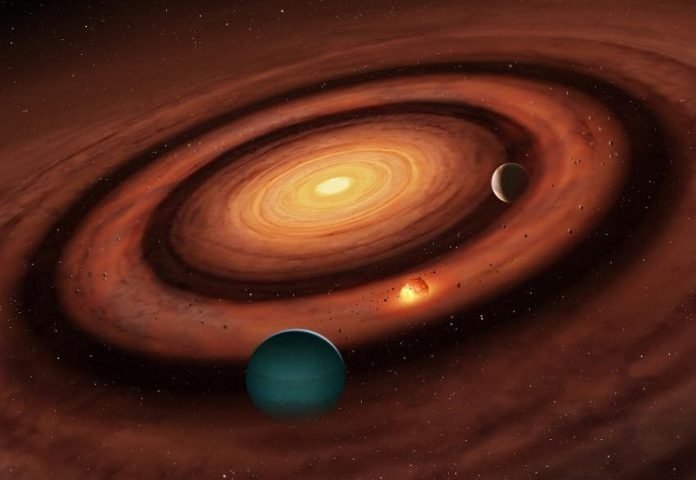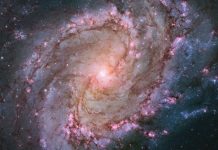
Scientists at the University of Warwick have uncovered a fascinating new explanation for how small planets might form.
By studying the “birth environment” of planets, known as the protoplanetary disk, the researchers have proposed a novel method of planet formation that they call “sandwiched planet formation.”
Their findings, which have been submitted to the journal Monthly Notices of the Royal Astronomical Society, were recently presented at the National Astronomy Meeting.
The protoplanetary disk is a region of swirling gas and dust that surrounds a central star.
The team at Warwick discovered that when two large planets exist in this disk, they can create conditions that lead to the formation of a smaller planet in between them.
This happens because the two outer planets hinder the inward flow of dust, resulting in a reduced amount of dust accumulating between them.
Consequently, if this dust were to come together to form a planet, the middle planet would likely be smaller than its neighbors, resembling the filling of a sandwich.
This new theory challenges previous research and provides a potential explanation for the formation of small planets like Mars and Uranus, which are each surrounded by larger planets.
The scientists propose that the gaps observed in protoplanetary disks are where planets are likely to form, with the dust rings just outside these gaps indicating the presence of planets. The rings themselves serve as sites for the formation of sandwiched planets.
Associate Professor Farzana Meru, a leading researcher in this study, explains that this sandwiched planet architecture deviates from the conventional view of planet formation, where planets are believed to form sequentially from the inside to the outside of the disk, increasing in size as they move further out.
The team’s findings are particularly intriguing because they align with observations of exoplanets, which also exhibit this sandwiched planet structure, where the middle planet is less massive than its neighboring planets.
The field of planet formation has experienced significant advancements in recent years, thanks to the advent of advanced telescopes like the Atacama Large Millimeter/submillimeter Array (ALMA).
These telescopes have provided high-resolution images of planet-forming disks, offering valuable insights into how planets form and evolve. Researchers like those at the University of Warwick are at the forefront of this exciting research, working to unravel the mysteries of planet formation.
This groundbreaking discovery opens up new avenues for further research, as scientists strive to better understand the complex processes that shape our universe and the origins of planets.
By exploring the unique dynamics of protoplanetary disks and the intriguing sandwiched planet formation, scientists are unraveling the secrets of planetary systems, bringing us closer to unraveling the mysteries of our celestial neighborhood.
Follow us on Twitter for more articles about this topic.



